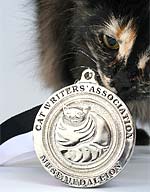 |
|||||||||||||||||||
|
|

We are the proud winners of the 2006 - 2009 winner of the Muse Medallion for Online Magazine by The Cat Writers? Association in their annual Communications Contest! (Photo courtesy of Weems Hutto).
On November 17, 2007 Felinexpress.com was honored to receive The President's Award by the Cat Writers' Association. We are very proud to have earned this distinction and will continue to provide quality information for all cat lovers.
Felinexpress.com home > Cat Care > Brushing your cats teeth |
Brushing your cat's teeth: Dental health
“Have you brushed your teeth yet?” For most of us growing up, this was a familiar question from our parents before we went to sleep at night. For every cat owner, the importance of dental health and their cat should be taken just as seriously. A cat’s mouth contains both harmless and harmful micro organisms; Pasturella multicida (this bacteria causes acute septicaemia) and Streptococcus (bacteria that causes strep throat) these two microorganisms can thrive with little to no oxygen.
Because the mouth stays wet, the moist environment promotes growth of bacteria causing tooth decay and gum problems. Although cats don’t dive into boxes of chocolates or other sugary snacks this does not diminish the danger of cats developing gingivitis, stomatitis (inflammation of the mouth) and other types of periodontal diseases.
Untreated, these types of infections can cause tooth loss, kidney and heart disease and eventually even death.
Examine your cat’s mouth
- Scruff kitty gently while kitty is on an elevated surface.
- Kneel down in front of kitty; raise her head gently, until she is looking at the ceiling.
- Tickle the side of her mouth with your finger to see if she will open her mouth. You can also use a plastic straw. She will open her mouth and bite on the straw. Once she clamps down, raise her lip and examine her gums.
- They should be “pink and happy” (as my vet says). Pressing your finger lightly against the gums, should cause the gums to go white, then pink up in seconds. This is a healthy mouth.
Problems to look for
- Broken teeth
- Bleeding gums.
- Red lines appearing above the tooth line.
- White, pasty looking gums.
- Bumps or blisters on the gums.
- Excessive drooling.
- Bad breath.
Outside symptoms of mouth pain
- Pawing at the mouth.
- Refusing to eat.
- Unwilling to let you touch their face.
- Refusing to groom themselves.
According to the American Veterinary Dental Society, eighty-five percent of cats over the age of four show some signs of periodontal disease.
In order to have their teeth cleaned, cats have to be put under anesthesia for a proper cleaning and scraping. Advance gum disease can lead to bone loss, loose teeth and tooth extractions.
Tooth extractions are painful and stressful on the cat. Because of how some cats gulp their food, swallowing dry pieces whole, feeding just dry kibble is not adequate enough to clean a cat’s teeth.
Stray cats will often gnaw on raw bones, pieces of wood and even rocks when their gums are inflamed in an effort to feel better.
Brushing a cat’s teeth
Brushing a cat’s teeth does not have to be difficult. On the market today are various flavors of cat-attractive meaty flavors that will motivate your kitty to open up and say “Ahhh!” Starting a regiment of brushing teeth can be done is small stages. There are special toothbrushes for cats you can use, but a child’s toothbrush is also acceptable.
- Use your finger, a washcloth or a cotton swab and apply some cat toothpaste to it.
- Pull up the cat’s side of the mouth gently and lay the finger or the swab on the gum. Swipe the toothpaste on the gum, rubbing gently.
- Repeat on both sides of the mouth and the front.
- Give kitty a tasty treat for tolerating this invasion of her mouth.
- Repeat this procedure several times a week.
Never use human toothpaste on cats! Toothpaste that we use is extremely toxic to your animal. If you read the label of any toothpaste meant for humans you will see the following caution: “harmful or fateful if swallowed.”
Unlike us, cats don’t need to rinse their mouth after being brushed. Cat toothpaste is perfectly safe to stay in the mouth and even eventually to swallow.
Some cats cannot tolerate the toothbrush against their gums, perhaps it tickles? So any way you can introduce the cat paste in their mouths is a victory.
There are also tarter-control treats available, although not entirely effective, especially if your cat is a gulper, not a nibbler.
Regular dental check-ups are also important to maintain your cat’s good health.
Dental gels and rinses for cats are also available.
Studies show that relatively few cat owners brush their cat’s teeth on a regular basis. If they did, perhaps they could avoid some of those costly vet visits they encounter later down the road.
More cat breeds |
|
? Copyright 2006-2010 Felinexpress.com, All Rights Reserved
Privacy Statement - Disclaimer - About Me


